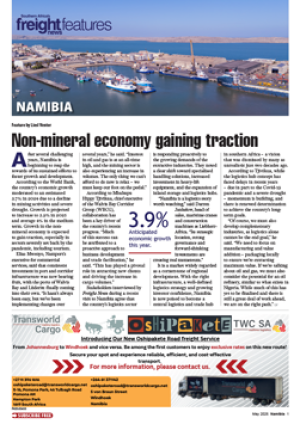Dirk Hoffmann,
Safmarine Southern
African cluster
manager, foresees
distinct changes in shipping in
the next decade, which will all
have a profound effect.
Purchasing decisions will
be inf luenced by more than
price and product. “The quality
of a shipping line’s customer
service is likely to become
even more important,” he told
FTW. “This as shipping as an
industry becomes even more
commoditised and there is little,
if any, variation in the product
and price offerings of different
shipping lines.”
Hoffmann also sees a
continued focus on cost
and cost management.
“Container shipping,” he
said, “is a capital-intensive,
narrow-margin business and
we expect profit margins to
remain under pressure in the
decade ahead.
“But one area where we do
have control is over our
costs.”
There will be
a change in
manufacturing
patterns.
A change in
manufacturing
patterns,
which has led
to increased
local
manufacture,” he said, “is likely
to impact shipping in a number
of ways. Not only will it continue
to bring about a change in the
types of goods moved and the
volumes moved, but it is also
likely to support the balancing of
trades.”
A more disciplined shipping
process is also inevitable.
“More and more countries are
imposing stricter regulations
– such as requiring upfront
documentation,” according to
Hoffmann. “And this will result
in a more disciplined shipping
process.”
There will be an increased use
of e-business tools and channels.
“The emergence of e-business
tools and channels has brought
with it increased convenience,
speed and efficiencies,”
Hoffmann said. “And the
shipping industry is likely to
continue benefiting from the
development of innovative
e-business technologies.”
“Safmarine supports the drive
for increased e-commerce in
shipping because we see benefit
for all parties.
There will be
shorter cycles
and higher/
deeper peaks
and troughs.
Said
Hoffmann:
“Shipping
has always
been a
cyclical
industry. But in recent years,
we’ve seen the cycles shorten, the
peaks heighten and the troughs
deepen.
“Longer-term contracts
between shipping lines and
shippers are likely to increase
in order to provide some level
of stability to this f luctuating
situation.”
Smarter containers will be
developed.
“Improved container
technology has already made
a huge difference to the reefer
industry,” said Hoffmann.
“The introduction of global
positioning systems (GPS)
and temperature recording
technologies will allow reefer
customers to not only keep
track of their containers but will
provide them with access to full,
real-time data. These are further
examples of the ‘smart container’
trend.”
With a continued focus on
environmental issues, slow
steaming is here to stay,
according to Hoffmann. Also
he sees an on-going focus on
green technologies and a greener
supply chain.
More ‘hub and spoke’ systems
and transhipment is another
inevitability.
“As vessel capacities increase,
so too will the introduction
of ‘hub and spoke’ systems,”
Hoffmann said. “Transhipment
has been a growing trend over
the past two decades. It is
estimated that in the mid-80s,
one in every ten containers was
transhipped. Today, the number
is closer to one in four, or,
depending on the trade, even one
in two.”
And how does Hoffmann see
a more modern shipping process
transpiring?
“Many of the shipping
processes still in use today
were implemented centuries
ago,” he told FTW. “Shipping
companies alone will not be able
to modernise shipping.
“Any change in shipping
processes will have to be
supported by the financial, legal
and regulatory systems and the
stakeholders involved.”
INSERT & CAPTION
Any change in shipping
processes will have to
be supported by the
financial, legal and
regulatory systems and the
stakeholders involved.
– Dirk Hoffmann
CAPTION
Charting a future course ... there will be continued focus on cost and
cost management. Photo: Safmarine

